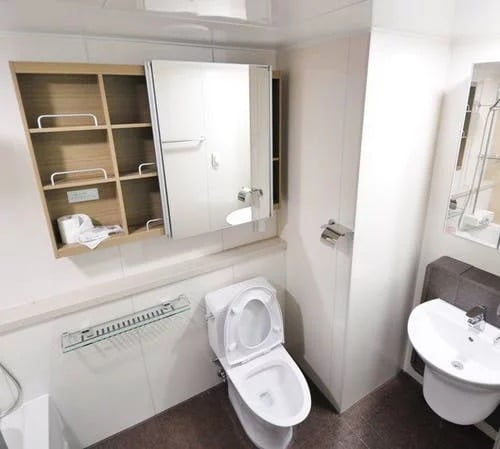Why Does the Shower Get Hot When the Toilet is Flushed?

Why does the shower get hot when the toilet flushes? You can fix your water pressure issue and never scald anyone in your household again. Learn more about the answer to this ageless question.


Why does the shower get hot when the toilet flushes? You can fix your water pressure issue and never scald anyone in your household again. Learn more about the answer to this ageless question.
Why Does the Shower Get Hot When the Toilet is Flushed?
It’s a question that has plagued mankind since the introduction of indoor plumbing — why does flushing the toilet, or even running the tap, cause such a difference in the temperature of the water in your shower? What’s to be done about it?
Actually, that sudden jolt of scalding hot water in the shower is caused by the way your water pressure and your water heater work. And you don’t have to go through life never flushing a toilet or turning on a tap while someone is in the shower. You can fix your water pressure issue and never accidentally scald your spouse, children, or houseguests again.
Water Pressure and Your Shower Temperature
The reason your shower temperature changes when you flush the toilet has to do with how your water heater and home plumbing are configured. The plumbing in most homes follows a trunk and branch configuration. Two main pipes draw water from one side of your house to the other — there’s one pipe for cold, and one for hot. Both come out of the water heater. These pipes are the main trunk for your home’s plumbing.
Smaller pipes, or branches, come off of your home’s trunk pipes to connect your sinks, showers, toilets, clothes washers, and dishwashers to your home’s main plumbing trunk. If your home’s water pressure is on the lower side, then any fixture that takes water out of the trunk also takes water away from any other fixture that is currently in use.
In some homes, the same water line supplies the hot and cold water to all of the fixtures in the bathroom, exacerbating the problem. Whenever a toilet is flushed, it takes cold water away from the shower, so that only the hot water is left. Sometimes, this can mean that using a washing machine, dishwasher or sink in a different room can also lower water pressure enough to raise the temperature of the shower if it is in use at the same time because these fixtures can also take cold water away from the shower.
Thinking about coverage?
Security for your home. Protection for your budget.
Stabilize Your Home’s Water Pressure
If your shower gets scalding hot when a toilet is flushed, that doesn’t necessarily mean that everyone else will have to wait while someone is in the shower. You can balance the water pressure in your home so that flushing a toilet doesn’t take cold water away from the shower.
There are a couple of options available to you, depending on your appetite for big plumbing jobs. If your desire to tackle a plumbing project is low, that’s understandable, but you can mitigate the shower temperature problem by slightly closing the water supply valve on your toilet. Close the valve enough that the tank fills more slowly, but not so much that it doesn’t fill at all. This should lower the impact of a toilet flush on your home’s water pressure and make it so that your toilet takes less cold water from your shower when flushed.
If you’re up for a bigger project, you can install a pressure-balanced valve on your shower. This will compensate for a sudden drop in water pressure caused by a flushing toilet by reducing pressure in the hot water line to match the reduction in pressure in the cold water line. This will keep your shower temperature stable when toilets or other fixtures are used while someone is in the shower.
Another option would be to identify and address the causes of low water pressure. You could increase the size of your supply lines or install a central load manifold to replace your home’s trunk and branch plumbing system. However, these solutions are much more complex and expensive. Installing a manifold, in particular, will require a renovation of your home’s entire plumbing system, so it probably won’t be worth it just to avoid getting scalded in the shower. The easiest and cheapest way to correct the problem is to slow the flow of water into the toilet, and the second-easiest and cheapest way is to install a pressure-balanced valve.
The mystery of why flushing your toilet affects your shower temperature isn’t so hard to solve. Fortunately, you don’t need a complete plumbing overhaul to fix this issue. And for other plumbing problems, an American Home Shield® home warranty can help. Our home warranty plans cover the parts of up to 23 systems and appliances you rely on every day. inclusing your HVAC, plumbing, electrical, refrigerator, washer and dryer, and more.
See how a plumbing protection plan can help with covered repairs.

AHS assumes no responsibility, and specifically disclaims all liability, for your use of any and all information contained herein.
Have a plan for your home when things don't go according to plan
Shop Home Warranties